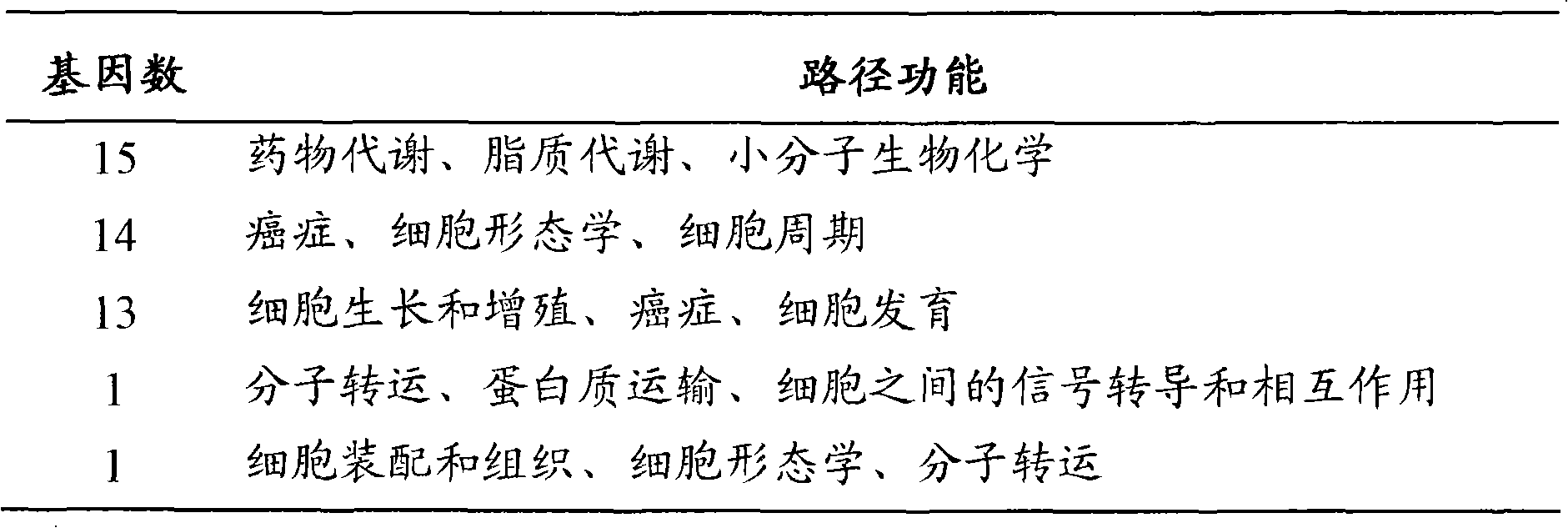Mirna regulated genes and pathways as targets for therapeutic intervention
A pathway and gene technology, applied in the fields of molecular biology and medicine, can solve the problem of unknown details of regulatory pathways and networks
- Summary
- Abstract
- Description
- Claims
- Application Information
AI Technical Summary
Problems solved by technology
Method used
Image
Examples
Embodiment 1
[0277] Analysis of gene expression after transfection with HSA-MIR-16
[0278] miRNAs are believed to affect gene expression mainly at the translation level. Translational regulation that leads to up- or down-regulation of protein expression can lead to changes in the activity and expression of downstream gene products and genes, which in turn are regulated by these proteins. These regulatory effects will be shown as changes in the overall mRNA expression profile. In addition, it has recently been reported that in some cases, miRNAs can reduce the mRNA content of their direct targets (Bagga et al., 2005; Lim et al., 2005), and the changes can be observed after microarray gene expression analysis. Microarray gene expression analysis was performed to identify genes misregulated by hsa-miR-16.
[0279] The synthetic precursor miR-16 (Ambion) was reverse-transfected into quadruplicate samples of A549 cells, and each sample was performed at three time points. According to the manufa...
Embodiment 2
[0290] Cellular pathways affected by HSA-MIR-16
[0291] Misregulation of gene expression by hsa-miR-16 (Table 1) affects many cellular pathways that represent potential therapeutic targets for the control of cancer and other diseases and disorders. The inventors determined the identity and nature of the cytogenetic pathways affected by the regulatory cascade induced by hsa-miR-16 expression. Use Ingenuity Pathways Analysis ( Systems, Redwood City, CA) performs cell path analysis. The most affected pathways after hsa-miR-16 overexpression in A549 cells are shown in Table 2.
[0292] Table 2. Functional cellular pathways that are significantly affected after hsa-miR-16 is overexpressed in human cancer cells
[0293]
[0294] These data prove that hsa-miR-16 directly or indirectly affects the expression of numerous metabolism, cell proliferation, cell development and cell cycle related genes, and therefore mainly affects the functional pathways related to cell growth, development a...
Embodiment 3
[0296] Predicted gene target of HSA-MIR-16
[0297] Use proprietary algorithm miRNATarget TM (Asuragen) predicted gene targets for binding hsa-miR-16-1 and regulated by hsa-miR-16-1 and are shown in Table 3.
[0298] Table 3. Predicted target genes of hsa-miR-16
[0299]
[0300] ACACB
[0301]
[0302] AGTR2
[0303] ANAPC11
[0304]
[0305] ARHGEF4
[0306] ASPH
[0307] ATXN2
[0308] BCAS1
[0309] BNIP1
[0310] C10orf46
[0311] C14orf129
[0312] C18orf1
[0313] C1orf62
[0314] C21orf25
[0315] C6orf47
[0316] C9orf48
[0317] CAMSAP1L1
[0318] CCDC28A
[0319] CD22
[0320] CDC7
[0321] CEP350
[0322] CHST10
[0323] CLTB
[0324] COPS7A
[0325] CRSP9
[0326] CX3CL1
[0327] DCAMKL1
[0328]
[0329] DKFZp666G0
[0330] DNAJC5G
[0331] DUSP3
[0332] EFNB2
[0333] ELOVL6
[0334] ETS2
[0335] FAM3A
[0336] FBXO21
[0337]
[0338] FLJ14816
[0...
PUM
 Login to View More
Login to View More Abstract
Description
Claims
Application Information
 Login to View More
Login to View More - R&D
- Intellectual Property
- Life Sciences
- Materials
- Tech Scout
- Unparalleled Data Quality
- Higher Quality Content
- 60% Fewer Hallucinations
Browse by: Latest US Patents, China's latest patents, Technical Efficacy Thesaurus, Application Domain, Technology Topic, Popular Technical Reports.
© 2025 PatSnap. All rights reserved.Legal|Privacy policy|Modern Slavery Act Transparency Statement|Sitemap|About US| Contact US: help@patsnap.com

